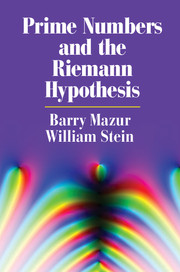Book contents
- Frontmatter
- Contents
- Preface
- PART I The Riemann Hypothesis
- 1 Thoughts About Numbers
- 2 What are Prime Numbers?
- 3 “Named” Prime Numbers
- 4 Sleves
- 5 Questions About Primes
- 6 Further Questions About Primes
- 7 How Many Primes are There?
- 8 Prime Numbers Viewed from a Distance
- 9 Pure and Applied Mathematics
- 10 A Probabilistic First Guess
- 11 What is a “Good Approximation”?
- 12 Square Root Error and Random Walks
- 13 What is Riemann's Hypothesis?
- 14 The Mystery Moves to the Error Term
- 15 Cesàro Smoothing
- 16 A View of|Li(X)-π(X)|
- 17 The Prime Number Theorem
- 18 The Staircase of Primes
- 19 Tinkering with the Staircase of Primes
- 20 Computer Music Files and Prime Numbers
- 21 The Word “Spectrum”
- 22 Spectra and Trigonometric Sums
- 23 The Spectrum and the Staircase of Primes
- 24 To Our Readers of Part I
- PART II Distributions
- PART III The Riemann Spectrum of the Prime Numbers
- PART IV Back to Riemann
- Endnotes
- Index
11 - What is a “Good Approximation”?
from PART I - The Riemann Hypothesis
Published online by Cambridge University Press: 05 May 2016
- Frontmatter
- Contents
- Preface
- PART I The Riemann Hypothesis
- 1 Thoughts About Numbers
- 2 What are Prime Numbers?
- 3 “Named” Prime Numbers
- 4 Sleves
- 5 Questions About Primes
- 6 Further Questions About Primes
- 7 How Many Primes are There?
- 8 Prime Numbers Viewed from a Distance
- 9 Pure and Applied Mathematics
- 10 A Probabilistic First Guess
- 11 What is a “Good Approximation”?
- 12 Square Root Error and Random Walks
- 13 What is Riemann's Hypothesis?
- 14 The Mystery Moves to the Error Term
- 15 Cesàro Smoothing
- 16 A View of|Li(X)-π(X)|
- 17 The Prime Number Theorem
- 18 The Staircase of Primes
- 19 Tinkering with the Staircase of Primes
- 20 Computer Music Files and Prime Numbers
- 21 The Word “Spectrum”
- 22 Spectra and Trigonometric Sums
- 23 The Spectrum and the Staircase of Primes
- 24 To Our Readers of Part I
- PART II Distributions
- PART III The Riemann Spectrum of the Prime Numbers
- PART IV Back to Riemann
- Endnotes
- Index
Summary
If you are trying to estimate a number, say, around ten thousand, and you get it right to within a hundred, let us celebrate this kind of accuracy by saying that you have made an approximation with square-root error (√10,000 = 100). Of course, we should really use the more clumsy phrase “an approximation with at worst square-root error.” Sometimes we'll simply refer to such approximations as good approximations. If you are trying to estimate a number in the millions, and you get it right to within a thousand, let's agree that – again – you have made an approximation with square-root error (√1,000,000 = 1,000). Again, for short, call this a good approximation. So, when Gauss thought his curve missed by 226 in estimating the number of primes less than three million, it was well within the margin we have given for a “good approximation.”
More generally, if you are trying to estimate a number that has D digits and you get it almost right, but with an error that has no more than, roughly, half that many digits, let us say, again, that you have made an approximation with square-root error or synonymously, a good approximation.
This rough account almost suffices for what we will be discussing below, but to be more precise, the specific gauge of accuracy that will be important to us is not for amere single estimate of a single error term,
Error term = Exact value − Our “good approximation”
but rather for infinite sequences of estimates of error terms. Generally, if you are interested in a numerical quantity q(X) that depends on the real number parameter X(e.g., q(X) could be π(X), “the number of primes ≤ X”) and if you have an explicit candidate “approximation,” qapprox(X), to this quantity, let us say that qapprox(X) is essentially a square-root accurate approximation toq(X) if for any given exponent greater than 0.5 (you choose it: 0.501, 0.5001, 0.50001, . . . for example) and for large enough X– where the phrase “large enough” depends on your choice of exponent – the error term – i.e., the difference between qapprox(X) and the true quantity, q(X), is, in absolute value, less than Xraised to that exponent (e.g. X0.501, < X0.5001, etc.).
- Type
- Chapter
- Information
- Prime Numbers and the Riemann Hypothesis , pp. 36 - 37Publisher: Cambridge University PressPrint publication year: 2016

